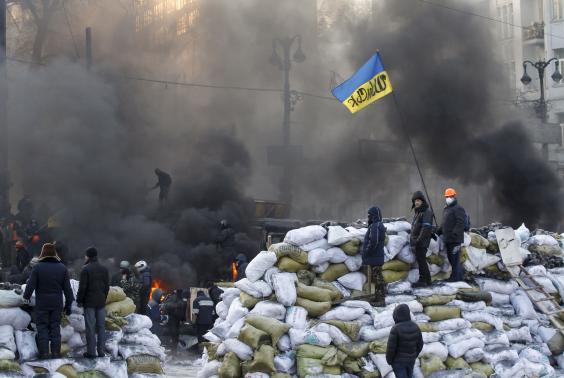Ukraine: Caught between Russia, the EU, and a Hard Place

BY CAROLINE WRAY:
The activity of the current crisis in Ukraine began less than three months ago, when now-ousted President Victor Yanukovych refused to sign an association agreement with the European Union. Yanukovych was elected President after nearly a decade of unease that began with the Orange Revolution: he won the national election in 2004 but did not take office due to countless allegations of voter intimidation and fraud. He lost the demanded recount to Victor Yushchenko, a much more European-friendly President, who served until Yanukovych secured the presidency in 2010.
The central conflict for the Ukraine is that it feels a pull towards both Europe and Russia. Citizens who claim to feel more culturally connected to Europe were outraged in November when Yanukovych, who is close to Putin, chose to strengthen economic ties to Russia at the expense of making connections with the European Union. Citizens gathered for “Euromaidan” Protests in Kiev. This process quickly turned from pro-Europe protests to direct protests of the perceived corruption of Yanukovych’s government.
Violence erupted in January as the government passed anti-protest laws, and the situation came to a bloody head from February 18-20 as 98 people were killed and thousands more were injured. Yanukovych, who is now in southern Russia, was removed from power, his party severed ties, and a warrant was issued for his arrest due to “mass killing of civilians,” referring to the deaths of protesters.

But in the last week, everyone’s eyes have turned from the protests to Putin, who has deployed troops in Crimea. The region, in the southeast corner of Ukraine and right on the border of Russia, has been historically Russian, and is 60% ethnically Russian. It was given—tensely—to Ukraine at the dissolution of the USSR, although historically it does not seem to have identified with Ukraine. It attempted unsuccessfully to form its own independent republic in 1992, and in 2009, anti-Ukraine protests were held by ethnic Russians.
And at the end of February, the Crimean Prime Minister (a position considered illegitimate by Ukraine) appealed to Putin for help, and by the first day of March Russia responded, sending troops to occupy the region. The West seems to have exploded with condemnation of the act as leaders struggle with how to punish Russia and exercise international control. Former Secretary of State Hillary Clinton has publicly drawn a direct parallel between Putin’s actions and those of Hitler in the 1930s. Secretary of State John Kerry is in Ukraine now, where on Thursday he reported that slow progress was being made.
This fact sheet from the State Department lists clearly the United States’ view of the situation in comparison to Putin’s, condemning each of his public justifications for invading Crimea. On Thursday, March 3, Obama officially placed economic sanctions and visa restrictions on Russians deemed to have been involved in the military action in Ukraine. The Moscow stock market is potentially in crisis mode as international investors have pulled out, and all the other seven G8 nations have agreed to suspend preparations for a G8 meeting in Sochi that was scheduled for June.
As nations condemn Russia’s actions, Crimea itself remains a deeply divided region. It has experienced both pro-West and pro-Russia riots in the last several days, and its official Parliament has named itself part of Russia, although Ukraine and the West deny this change.
The occupation of Crimea is a move on Russia’s part that is extraordinarily offensive to the West, and is obviously masked by Putin’s calls to “protect Russian citizens” located in Crimea. It is clear, however, that getting Russia to leave will be a very difficult task given the makeup of the Crimean population and the tensions with the West that have only continued to rise. It is also clear that the United States and its allies will continue to condemn Russia, slowly raising the heat if (and when) Putin doesn’t withdraw. What is unclear is when and at what cost, the heat will stop rising. There is universal desire for diplomacy to be sufficient means of resolving the conflict, but the tensions in Crimea are not new and will not dissipate easily or quietly. Keep your eyes on the news.
Caroline Wray ‘17 is in Jonathan Edwards College. She is a Globalist Notebook blogger on Russia. Contact her at caroline.wray@yale.edu.